
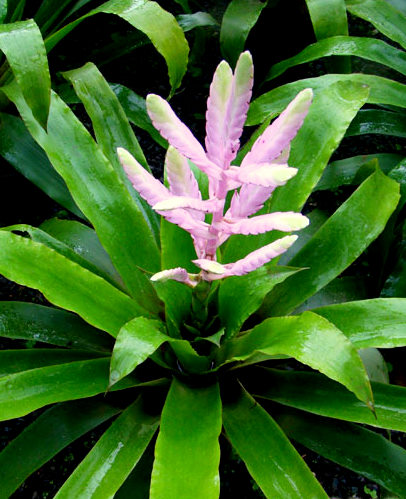
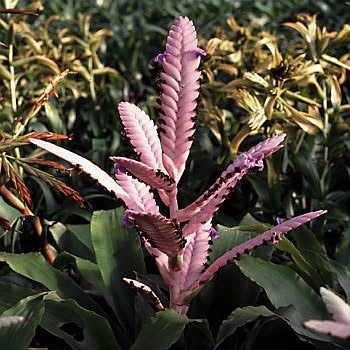
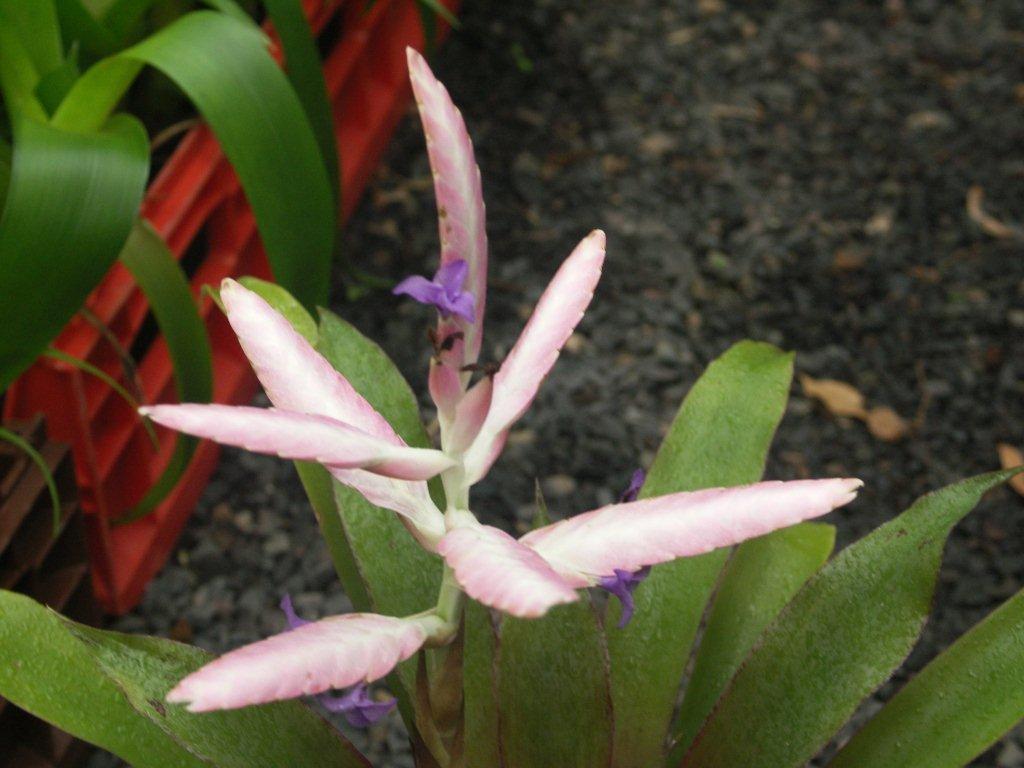
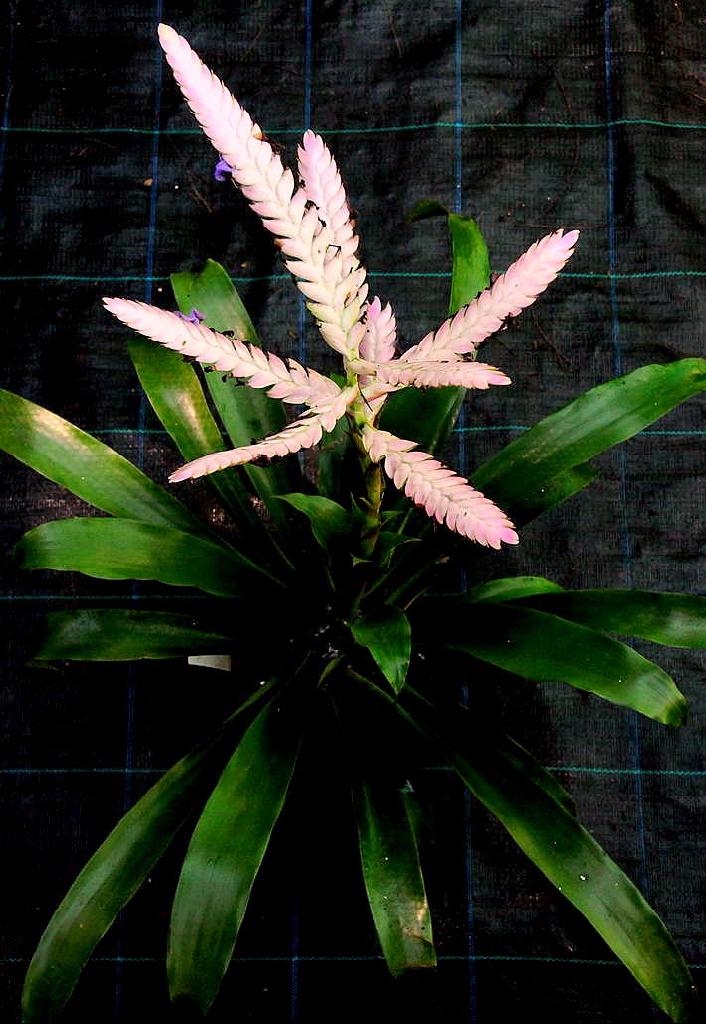
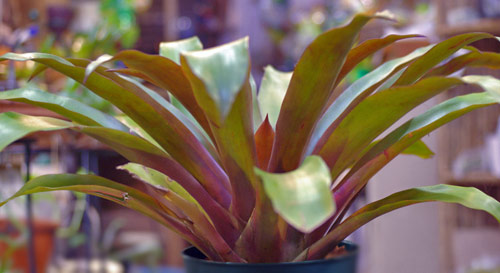

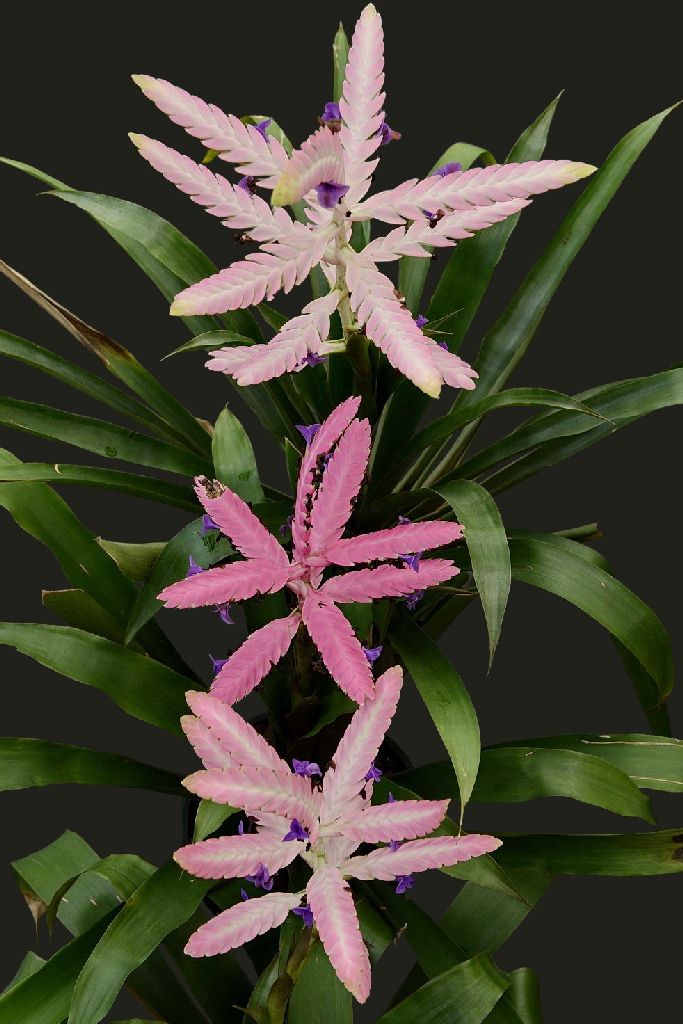

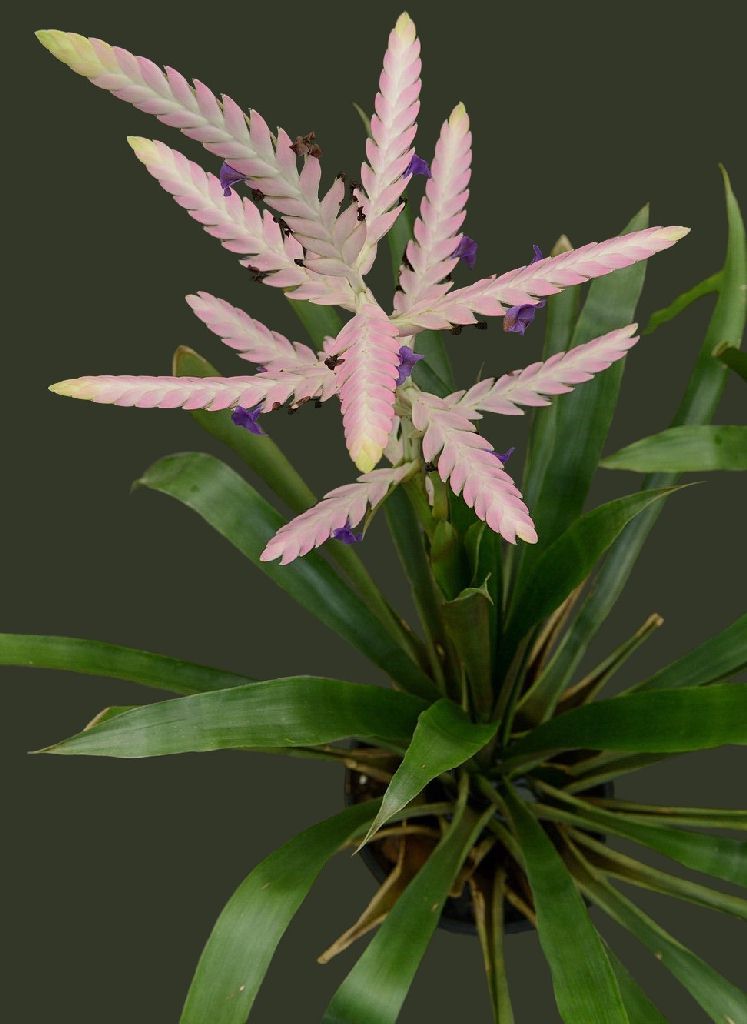
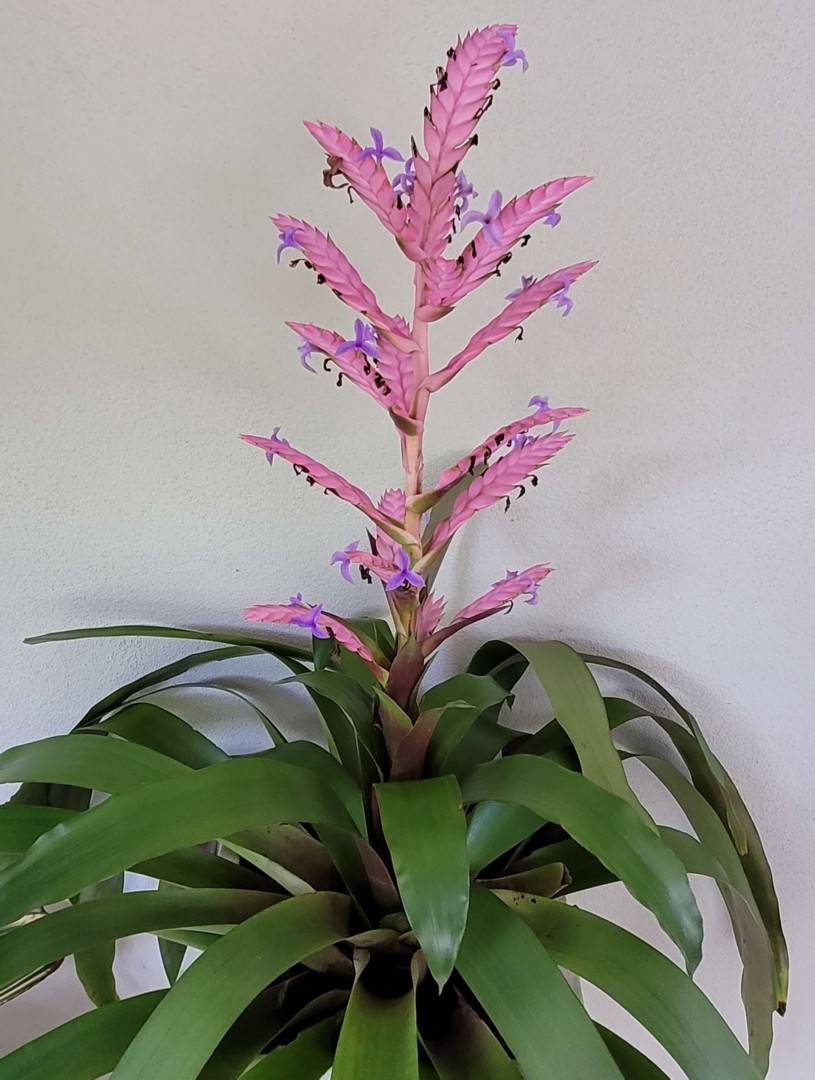
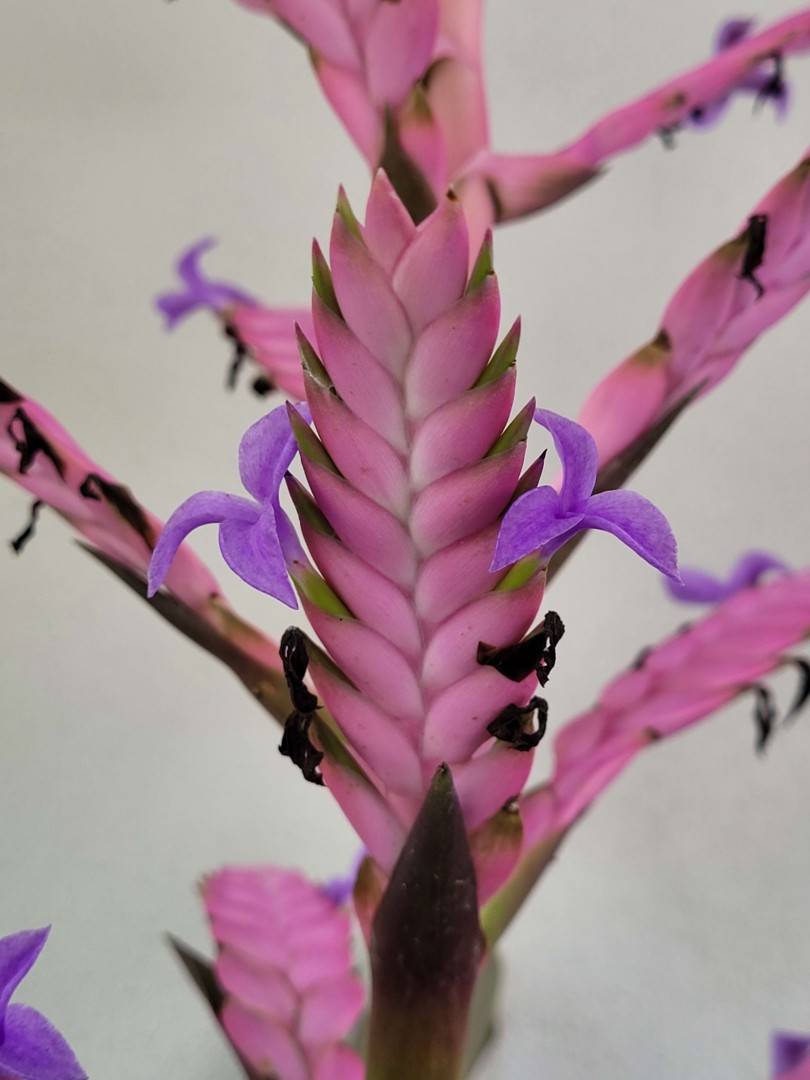
SOME NOTES ON TILLANDSIA WAGNERIANA
Some very interesting plants have already come to our competition tables this year, but when Laurie brought his pretty Tillandsia wagneriana to our February meeting it particularly caught my attention because ever since reading about this species when the Lee Moore article (reprinted on pp. 12-15 of this Newslink) was originally printed in our April 1997 Newslink, I had been fascinated by it.
In an article which appeared in the March/April 1979 edition of the Journal of The Bromeliad Society, Tillandsia wagneriana is described thus: “Exquisite is the term best used to describe this tillandsia with its delicate luminous pink inflorescence. Few tillandsias can surpass it in beauty. However, it is not for everyone, as it comes from the hot humid forests of Amazonian Peru and so is adapted only to greenhouse culture.” In another article, written by Professor Werner Rauh in 1970 (JBSI Vol. XX(3)), he describes it as being “One of the most spectacular tillandsias found within the last few years in Peru. … It is one of the green tillandsias and forms rosettes up to 40-50cm in diameter. The numerous leaves are lanceolate, about 45cm long, fresh green on the upper face and dull green on the lower face, frequently red-violet. From the centre of the rosette rises a branched inflorescence of a height of about 30-40 cm. This inflorescence is compound of 4-13 spreading spikes which have a length of about 10cm each and a breadth of up to 2cm. The most striking aspect of this plant is the colour of the bracts. They are bright pink. The colour of the floral bracts lasts about two months. In its vegetative state this plant does not need much light, but when the inflorescence is developing, more light will be necessary, otherwise the spikes will be only pale pink.”
By comparison, the ones we are seeing these days in Australia seem to be a little more cold tolerant than the original species (both Laurie and I have over-wintered our plants in shadehouses without any special attention to heating) but are only about half the size of those described above—both in height and in the number of leaves—and they tend more to have discolor leaves. When I queried this through the Till Nuts group, a suggestion was made that “The T. wagneriana you see on the market would have been originally selected for the European market and hence would have been selected on small plant/big flower! In any event it appears that if you grow discolor from seed you can get ordinary ones and discolor ones.”
TILLANDSIA WAGNERIANA
A Tribute To A Great Friend. By Lee Moore.

Much has been said and published about Tillandsia wagneriana but few, if any, know the significance of the name or the story behind it. It seems appropriate at this time, 30 years (now over 40—Ed.) after its discovery, to write another tribute to this species and its namesake.
Ronald Thomas Wagner and I had grown up, travelled and planned dreams of adventure together during our high school days of the 1950s. Ronnie was strong and fearless, but gentle and kind-hearted, with the mind of a scholar who loved poetry and Hillbilly music; truly a free spirit and a great and faithful friend. He had faced and fought death many times with almost a charmed life, having been bitten many times by various kinds of poisonous vipers and once losing a finger from the bite of a 6-foot Diamond Back Rattler during one of our treks capturing reptiles in the Florid Everglades for Bill Haast of the Miami Serpentarium. It took a violent plane crash in the northern coastal bush of Colombia to end his life on June 10, 1962. It has been said that he had seen and lived more experiences in his short 23 years than most in a lifetime.
Although Ronnie never had the opportunity to realize his dream of creating a serpentarium for venom extraction in Iquitos, Peru, which would have supplied a great world demand for medical and pharmaceutical research, he will always be remembered by his friends as a dearly loved friend who loved everything and everyone and never had a bad word to say about anyone or anything.
Later in my explorations of the Peruvian jungles, I was to be fortunate to discover one of the most beautiful bromeliads ever to be found: one that would carry a name worthy of the honour to whom it was due, ergo Tillandsia wagneriana. It was to be the first of many new species of bromeliads and orchids that I would find in the years that followed.
The details of the story that led to the discovery of this plant are only of significance to me but I would like to share an abbreviated account of it again.
During our high school days, while others attended basketball games, dances, drive-in movies and other normal high school activities that kids at that age do, Ronnie and I would be wading around in the deep swamps of the Florida Everglades with a flashlight searching for and capturing Cotton Mouth Moccasins, Rattlers, Coral snakes and Alligators. These were our normal weekend activities, every day and night in the Everglades. It was in the Everglades that I first became interested in orchids and bromeliads which were abundant at that time and were included in our collections.
We used to dream and plan together of one day going to South America where the really important and more interesting things were to be found: he to establish a serpentarium for venom extraction and I to establish a nursery and explore for new and exciting species.
Later on, in 1960, I was introduced to Peru by one of the local tropical fish importers who sent monthly charters to Iquitos on the Amazon River. This was the beginning of the real adventures of which we had dreamed. I had the good fortune to make several trips there in the beginning on the antiquated WWII C-46 cargo plane that he chartered—a 14-hour flight at low altitudes, (which now takes only 5 hours) at very high altitudes, seeing nothing along the way. It was on these trips that I discovered the location of the long-sought-after Aechmea chantinii and several very important orchid species. Later on I would find the Aechmea ‘Pink Goddess’ and many others, including Aechmea mooreana and Neoregelia mooreana, etc.
I introduced Ronnie to Iquitos, who accompanied me on one of these trips, and promptly found an abundance of Fer de Lance (Bothrops), Bushmaster and many other vipers. One of the Bushmasters turned out to be a world record of 12.2" (370.84 cm). So, it was decided that Iquitos was to be the beginning of our dream and plans for our future enterprises were set in motion; but, as fate would have it, the end of the dream for Ronnie.
During the next year we laid down our plans to establish our projects. We betted, borrowed and stole, so to speak, the needed financing to purchase the equipment for our respective projects and to make the big move towards realizing our dreams of many years. Ronnie had worked with Bill Haast of the Miami Serpentarium, having learned the technology of venom extraction and the freeze-drying process for venom research which was in great demand and highly profitable, but dangerous. He had also learned from Haast the technology of immunization, by administering minute doses of venom to himself over a period of time, creating antibodies, until a full dose, from the dangerous reptiles that he would be handling, would have little effect. So he was prepared. This was not a lark or an adventure, but a very serious undertaking with sophisticated laboratory equipment and knowledge of the subject. I had already established myself in the plant business with the discovery of Aechmea chantinii and several important orchids and had created a successful mail order business. So I, also, was prepared for the big move with assurances of success.
In June of 1962 the big day came. We had chartered an old WWII surplus B-26 bomber, converted for cargo, to carry us and our equipment to our new life and future in the Amazon. It was the only thing that we could afford at the time. But a complication arose in that the FAA would only permit one of us to accompany the flight since, technically, there was only one seat for a passenger, which was an oil can with a seat belt. We were faced with the dilemma of deciding who was going to ride that seat; the other would have to buy passage on a commercial carrier, which in those days to Iquitos was sporadic at best. Jet service had not yet been established, but the decision had to be made. We flipped a coin: Ronnie won the toss. I tried to convince him to trade places with me and I would pay for the commercial ticket down because I was taking my big German shepherd with me and I wanted to care for him along the way. But Ronnie loved ‘Buck’ and assured me that he would be in good hands. So it was settled. I left a few days earlier to make my way to Iquitos via Lima, on to Panagra, then Faucett, to await the arrival of the B-26 with Ronnie, Buck and our cargo.
The night before my departure, I had a dream that a plane had crashed with three occupants: two pilots and a passenger. I could not see faces, but two walked away and the other did not.
I told this to Ronnie and will never forget his forlorn look and half serious but joking response, “Tell me Lee, did I walk away?” But I could not. I was left with an ominous premonition but could not put credence in a dream and neither could he, so we chalked it up as the result of excitement for the trip and it was forgotten…for the moment.
The week passed in Iquitos with no news and communication, in those days, was very difficult. One afternoon as I sat in a local cantina, one of the tropical fish dealers came to look for me with the news that the plane had crashed in Colombia 3 days ago and Ronnie was critical. The two pilots sustained serious injury but had survived. Then I remembered the dream. Had I seen into the future? But how could I have really known?
With the last $500 in my pocket, I made my way back to Lima on the first available flight and then to Barranquilla which was the city closest to where they had gone down. It was not hard to locate Ronnie or the crash because it was still being covered in the local newspapers. I did not speak Spanish at the time, so I hired a translator guide to help me get about in my quest. I found Ronnie in a coma with his legs and arms in casts but the brain concussion was the critical part from which he would never regain consciousness.
Since there was nothing that I could do to help him at the moment, I visited the crash site to see if there was anything that could be salvaged. I knew that Buck would have been killed, but I had to try. When I arrived at the crash site, I saw that salvage was hopeless because anything of any value had already been carried away by the local people but there was no dog. I enquired about a large black and white dog and to my joy and surprise, was told about a big wolf that had come down from the hills about the time of the crash to eat the bodies. They had tried to kill it but he had escaped.
To make a short story of a longer one, I spent the next three days, while Ronnie remained in a coma, searching for Buck. I had, by then, enlightened the locals about the big 'wolf’ and the whole population was scrambling about trying to claim the reward that I had offered. I had seen signs of him everywhere and received daily reports that he was seen here and over there but each time he eluded us out of fear and confusion. On the third day, I decided to camp under a piece of the plane wing hoping that he may return to the only familiar place that he knew there. About 2 am I heard the familiar jingle of his collar tags and called his name. The jingle abruptly stopped. I called again and there he appeared under the moonlight in the swath made by the crashing plane. He crawled to me as if in humiliation thinking that he had been a bad doggie and had done something wrong. It was a tearful and happy reunion. The saga of this search and reunion had become well known and was covered in a big story in the local papers. The story went out over the wires and was picked up by Time Magazine and some of the larger U.S. papers as a human interest story. So Buck became a celebrity.
The next day I was talking to Ronnie as if he could hear me. His father and uncle were present by that time to make whatever arrangements that may become necessary. As I was talking to him, he took one big breath through the tube inserted in his throat and expired. I made a promise to him that I would make sure that he would never be forgotten and his name would live in something of beauty that others would see, appreciate, and remember for as long as it existed.
After arrangements had been made to send Ronnie back to Miami, I was depressed and confused, not knowing what to do. I was out of money and had lost everything but Ronnie had lost more. When I was preparing to leave my hotel and return home, an unusual message was received. The message was from a police station in a small village about 20 miles from the crash site. It said that they may have some items of interest to me after having read about my plight in the newspapers. I went there and found a rickety wooden building with crumbling plaster walls which was the police station. I was shown to a room with a pile of crumpled pieces of the plane wreckage that had been confiscated from the people who had carried it away. My spirit, which had already been broken, fell a little further when I saw a pile of junk which consisted of pieces of twisted aluminium and hydraulic lines from the plane. But then, all of a sudden, underneath it all was a grey metal box: the box that carried the 3x5 index cards with the names and addresses of my customers which was the heart of the mail order business that I had worked for so hard to build and was the reason for my move to Iquitos in the first place. I knew then that I could continue somehow, even though I had lost my friend, my equipment, and my money was exhausted. The box had been bent in the crash so that the two drawers were sealed and the cards were intact. It was a miracle. This was the sign that I needed to continue. Returning to the hotel, there was another message. This one from the airlines offering Buck and myself First Class passage back to Peru for the publicity use of the then famous dog. And so it was, on June 10, 1962, I returned to Iquitos with one suitcase, a box of cards and a celebrated dog. The serpentarium was not to be.
Friends and family pleaded for me to return home, get a job and settle down. I told them that the price that had been paid for this project was already too great to give up and abandon it now. I was determined that the dream would be realized. In the months that followed, I was able to borrow a small amount of money from friends and family to put a small down payment on a piece of land on the Amazon River, with a small wooden house and a dugout canoe with motor. I was able to put together a small shade house with thatched palm fronds which was the beginning of a nursery and began my explorations and collections to supply the mail order business for the next few years until another plane crash that caused me to return home for a while--but that is another story.
During the first months in Iquitos, I had heard about a very remote town in the jungle hills at the base of the Andes called Moyobamba which sounded very interesting. At that time there were no roads to that area and the only way to get there was by a small DC-3 that flew in sporadically about once every week or ten days. When I arrived in Moyobamba for the first time, 3 months after that terrible June of 1962, I fell in love with the place and somehow knew that, someday, this would be the place that I would spend the rest of my life. It was a sleepy little town with dirt streets on top of a plateau nestled in a beautiful valley, with a big sugarloaf mountain called 'The Moro', in low mountain jungle with a pleasant climate; not steamy hot like Iquitos. The houses were all adobe with tile and tin roofs with orchids and bromeliads growing everywhere--right on the clay tiles and covering the fruit trees in the yards.
Little did I know at the time, that this would become the place of many new and exciting discoveries for me in the future.
I was the first to ever go there looking for orchids and bromeliads. Since then, the town has been destroyed twice by earthquakes and rebuilt so it has greatly changed from what it was. Today there are roads and daily jet service to that area. I live there today with 57 acres to develop into a nursery. Moyobamba will be the subject of many adventure stories in the future.
During those first two weeks that I spent there walking out into the jungle in different directions each day, one day was very special. I came across a little patch of cleared land with a small thatched house where a little old man did his farming. The old wrinkled man was squatting by a pot of boiling sugar cane juice which he offered to me to sip from a gourd ladle. Among the pineapples around his hut, a branched pink inflorescence caught my eye. Apparently the pink colour pleased the old man since he had planted this epiphyte in the ground to adorn his yard. I recognized this to be a tillandsia like none other that I had ever seen before. The old man pointed to a far ridge toward the north explaining that it was a day's journey to where they are found.
I spent the night with the old man, in anticipation of our journey the next day, and thought of this new tillandsia which I was sure would be a new species. Few would ever hear of my friend Ronnie Wagner and the great things that he would have done, but this bromeliad could be a memorial to him for as long as the horticultural world cherished it. At that moment, only I knew of this outstanding new bromeliad that was to be presented to the bromeliad world and no one would ever know, like I, the fantastic story behind it----Tillandsia wagneriana, 'In Memory of a Great Friend'.
At this point, I must make a confession. When I made my first important discoveries, such as Aechmea chantinii and a number of other orchids and bromeliads, I innocently and dutifully reported exactly where I had found them. Immediately, others flocked behind me to cash in on my hard work of literally blood, sweat and tears, which cost them nothing. I learned quickly to covet my future discoveries for a while so that others would not go behind me so easily after I had made all of the effort to find them. So I purposely reported that I had found T. wagneriana in the vicinity of Iquitos where I was living at the time. Surely enough, they came looking but did not find; because it really only comes from a very small micro-zone near Moyobamba 800 miles away from Iquitos and only I knew where it was. This information will have to be changed now. Now that it is in cultivation, I have since taken many collectors to this area.
I am proud to make this tribute to my friend, Ronald Wagner.
Tillandsia wagneriana L. B. Smith, Phytologia 9: 254, pl. 4, figs. 1-3. 1963.
desc from S&D p838-9
Plant flowering 4 dm high.
Leaves ca. 4 dm long, covered with fine pale appressed scales;
Sheaths elliptic, 8 cm long, castaneous;
Blades ligulate, acute, 35 mm wide, flat, becoming more or less glabrous above.
Scape erect, slender, glabrous;
Scape-bracts erect, much exceeding the internodes but not wholly covering the scape, broadly ovate, acuminate.
Inflorescence laxly bipinnate, 16 cm long;
Primary bracts like the scape-bracts, barely exceeding the short bracteate sterile bases of the branches;
Spikes divergent, linear-lanceolate, acute, to 10 cm long, 2 cm wide, strongly complanate, densely manyflowered or sublax at base.
Floral bracts ovate, acute, to 23 mm long, slightly exceeding the sepals, carinate and strongly incurved at apex, thin, nerved when dry, glabrous, pink (! Moore);
Flowers subsessile.
Sepals equally very short-connate, lance-oblong, acute, 21 mm long, the posterior carinate;
Petals blue, the blades spreading, broadly elliptic, 9 mm long;
Stamens deeply included, exceeding the pistil.
Type. L. Moore 310 (holotype US), vicinity of Iquitos, Loreto, Peru, cultivated D. Barry, Jr.
DISTRIBUTION, To 800 m alt, northeastern Peru.
PERU. AMAZONAS, Bagua: summit of Abra Huahuajin Pass, Rio Maranon highway below Montenegro, 21 Jan 1964, Hutchison & Wright 3690 (UC).